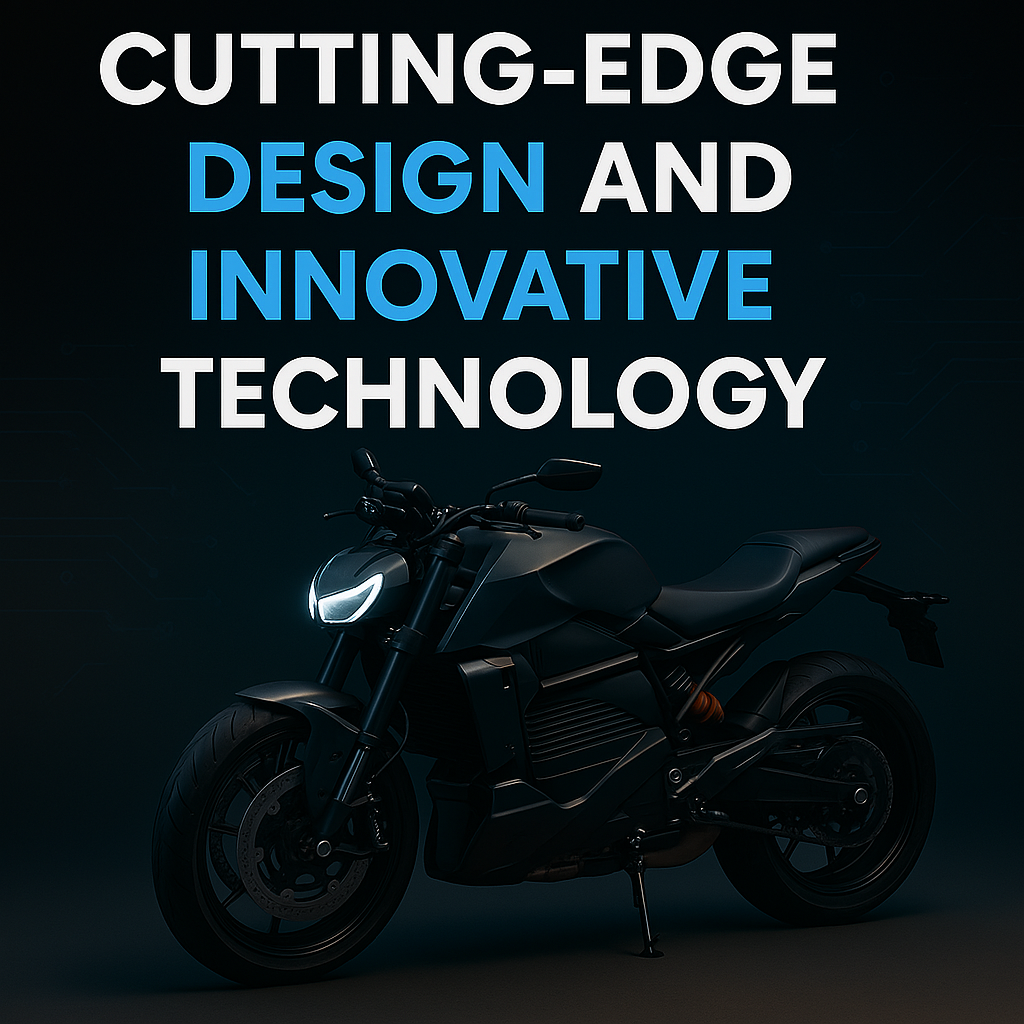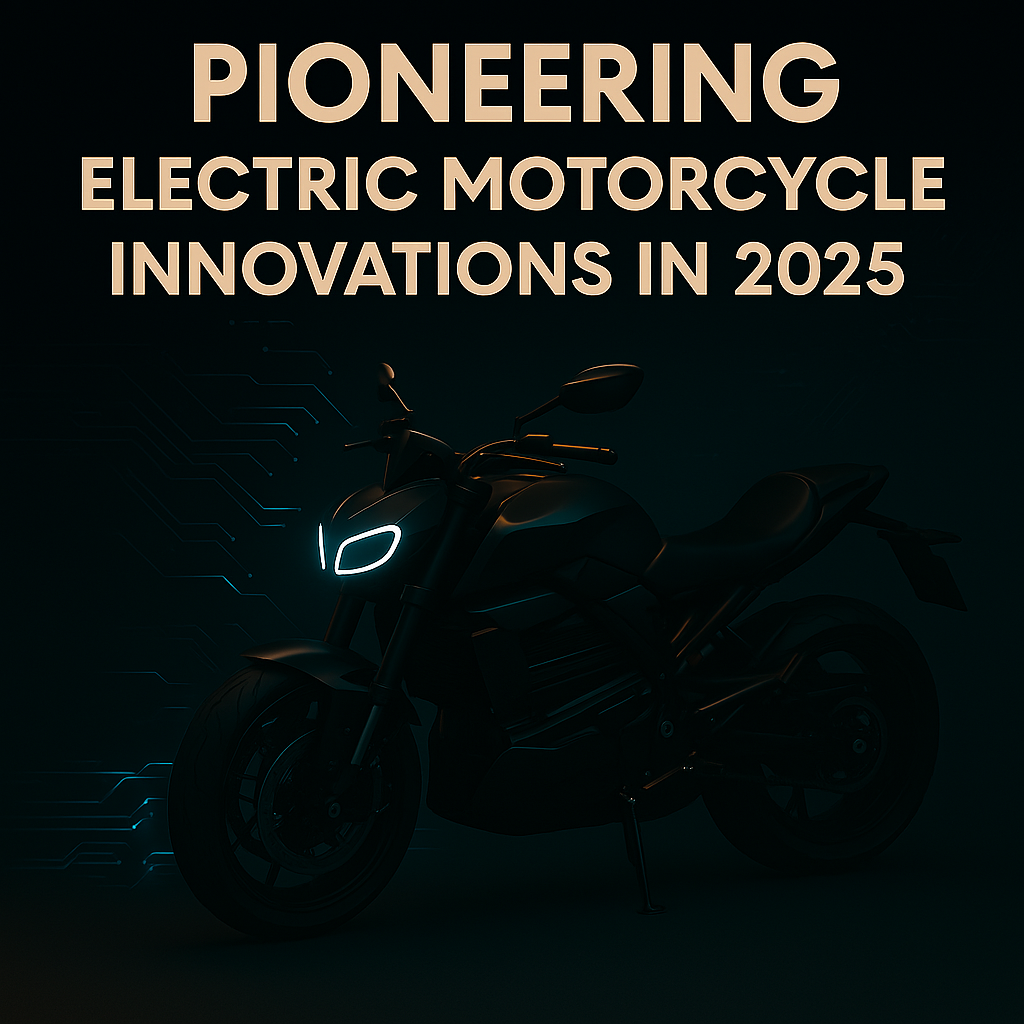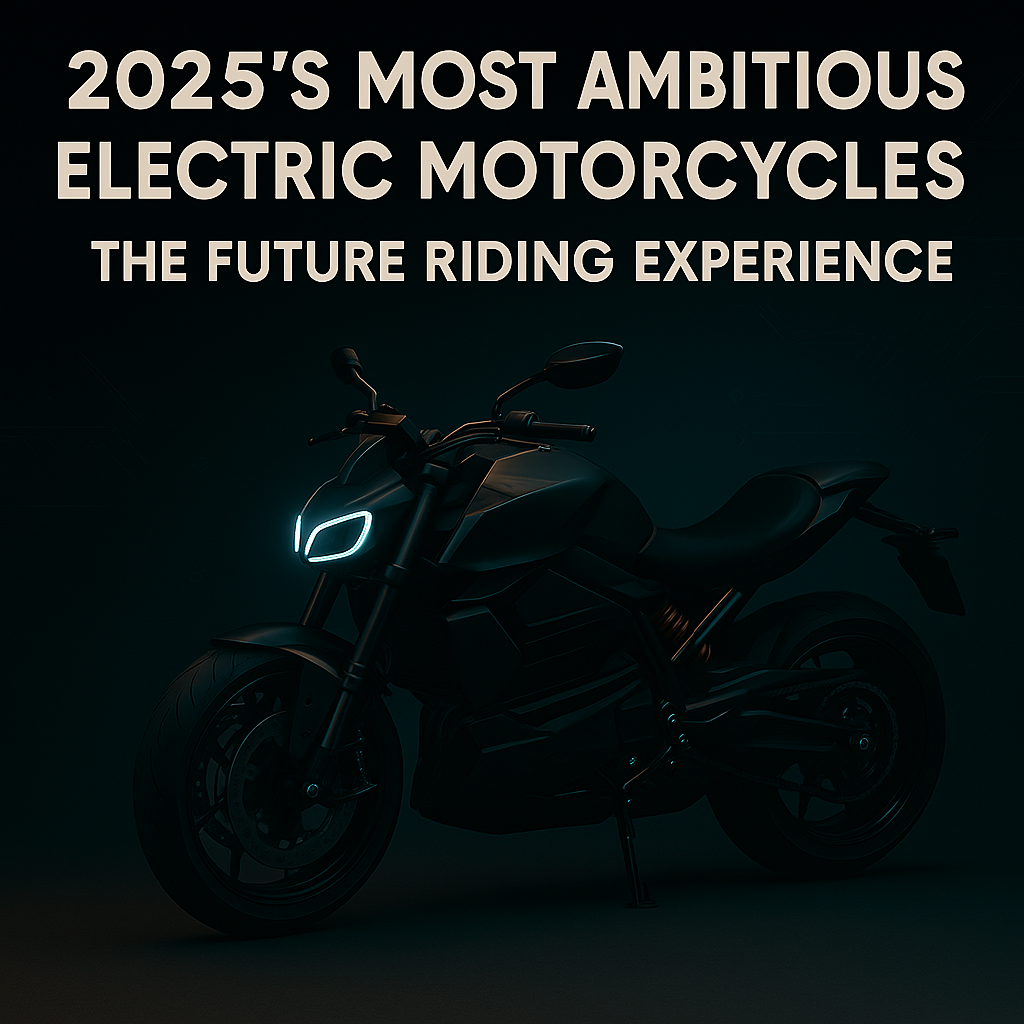Electric motorcycles are no longer a niche curiosity or an experimental prototype; in 2025, they have carved out their own vibrant niche in the world of high-performance, eco-friendly transportation. As we accelerate into the future, electric motorcycles embrace cutting-edge technology, revolutionary design, and a sustainable philosophy that redefines what it means to ride. In this blog post, we’ll explore how the most ambitious electric motorcycles of today blend futuristic innovations with the thrill of riding, and why they are becoming the vehicle of choice for urban commuters, tech enthusiasts, and adventure seekers alike.
Introduction: A New Era of Riding
In recent years, the global shift toward sustainable transportation has sparked enormous interest in electric vehicles. Among these, electric motorcycles stand out as symbols of speed, style, and environmental consciousness. In 2025, manufacturers and designers are pushing the envelope further than ever before. Gone are the days when electric bikes were seen as mere alternatives to their gasoline-powered counterparts. Today’s electric motorcycles are full-throttle machines that deliver powerful performance with zero tailpipe emissions.
This transformation is fueled by rapid advances in battery technology, smart connectivity, and integrated safety systems, all while maintaining the aesthetic allure and adrenaline rush that have long come to define motorcycling. Riders are not only embracing these modern marvels for their ecological benefits, but also for the innovative riding experience they provide—a seamless fusion of art, engineering, and digital connectivity.
In the paragraphs that follow, we’ll take an in-depth look at the evolution of electric motorcycles, explore the breakthroughs in design and technology, and examine how these machines are setting the stage for the future of riding. Whether you’re a motorcycling veteran or a newcomer curious about what the future holds, this comprehensive guide offers fresh insights, practical tips, and visionary predictions that capture the essence of a rapidly electrifying world.
The Evolution of Electric Motorcycles: From Novelty to Necessity
Electric motorcycles have come a long way from their early days as experimental prototypes. Initially, many enthusiasts were skeptical about whether battery-powered bikes could compete with the raw power and sound of traditional gasoline engines. Over time, however, relentless innovation has turned that skepticism into widespread excitement.
A Brief History
Historically, electric motorcycles had limited performance due to crude battery technology and rudimentary power electronics. Early models struggled with short ranges, slow acceleration, and minimal reliability under demanding conditions. As technology advanced, engineers began to refine electric motors, develop energy-dense batteries, and optimize weight distribution—all of which laid the groundwork for the sleek, high-performance designs we see today.
Current Transformation
Today’s electric motorcycles are engineered from the ground up, harnessing decades of research in electronics, materials science, and aerodynamics. They now feature:
- Advanced Powertrains: Modern electric motors deliver instantaneous torque that provides rapid acceleration and a thrilling riding experience.
- Enhanced Range: Battery packs have evolved, offering significantly longer ranges through improvements in energy density and thermal management.
- Robust Design: Lighter, more durable materials such as carbon fiber and advanced alloys have replaced heavier components, optimizing performance without compromising safety.
- Digital Connectivity: Integration with smartphone apps and onboard diagnostics allows riders to customize their experience and monitor performance in real time.
This revolution is not just about speed and efficiency—it represents a paradigm shift toward sustainable riding without sacrificing the daring spirit that defines motorcycling. By combining heritage design cues with futuristic technology, today’s electric motorcycles are designed to inspire riders and push the boundaries of what is possible on two wheels.
Cutting-Edge Design and Innovative Technology

The design of electric motorcycles in 2025 is a master class in blending form with function. Manufacturers are reimagining every element of the bike to reflect modern aesthetics while preserving the adrenaline-inducing emotions of traditional riding. Let’s explore some of the standout design and technology features transforming the motorcycle landscape.
Sculpted Aesthetics and Aerodynamics
Electric motorcycles are no longer constrained by the bulky designs of older generations. Instead, designers prioritize sleek, streamlined contours that not only look stellar but also improve aerodynamics. The flowing lines and carefully crafted curves reduce drag, enhance stability at high speeds, and contribute to overall performance. Key design elements include:
- Minimalist Exteriors: Clean, modern lines dominate, offering a futuristic appearance that still pays homage to classic motorcycle silhouettes.
- Integrated Lighting: LED headlamps, taillights, and accent lighting are built into the bodywork, providing superior visibility and an unmistakable high-tech vibe.
- Smart Geometry: The positioning of the rider, optimized weight distribution, and innovative chassis designs allow for a more dynamic riding experience, particularly during spirited cornering and quick accelerations.
State-of-the-Art Electronics and Connectivity
Electric motorcycles are increasingly becoming digital hubs on wheels. The integration of modern electronics significantly enhances both the performance and the user experience, making every ride as connected as it is exhilarating. Some of the highlights include:
- Digital Instrument Clusters: Gone are archaic analog gauges. Instead, riders are greeted with customizable digital displays that show everything from speed and battery levels to navigation and performance statistics.
- Smartphone Integration: Many motorcycles now offer seamless connectivity with smartphones, enabling riders to access maps, music, and communication features without taking their eyes off the road.
- Advanced Control Systems: Ride mode selectors, adaptive suspension systems, and real-time traction control algorithms allow the motorcycle to adjust dynamically based on road conditions and rider input.
- Over-the-Air Updates: Much like modern smartphones, these bikes can receive firmware updates that improve performance, address safety issues, and even introduce new features long after the sale.
Safety and Performance Innovations
By embedding technology deep into the heart of these machines, manufacturers are dramatically increasing both safety and performance. The next generation of electric motorcycles comes equipped with a suite of intelligent safety features:
- Automated Stability Controls: Sensors continuously monitor wheel speed, lean angle, and acceleration to help maintain stability, even on unpredictable road surfaces.
- Collision Avoidance Systems: Advanced radar and camera systems can detect potential hazards and alert the rider or even initiate corrective actions to prevent accidents.
- Regenerative Braking: Beyond improving efficiency by capturing energy during deceleration, regenerative braking systems provide smoother, more controlled stops while reducing wear on mechanical components.
All these technological advancements work collectively to create a riding experience that is as safe as it is thrilling—a true testament to the spirit of modern motorcycling.
Battery Technology: The Heart of Electric Motorcycles

At the core of every electric motorcycle is its battery system. In 2025, battery technology has reached new heights, transforming these bikes from limited-range machines into reliable, high-performance vehicles that can rival traditional internal combustion engines.
Improved Energy Density and Range
The most significant breakthrough in recent years is the remarkable increase in energy density. Advanced lithium-ion and emerging solid-state batteries now offer:
- Longer Ranges: Modern battery packs allow riders to travel further on a single charge, which is especially important for long-distance touring and daily commuting in urban environments.
- Compact Design: Batteries are becoming smaller and lighter, meaning more energy can be packed into a sleek, streamlined form factor. This reduction in weight translates directly into better acceleration and improved fuel efficiency (or rather, energy efficiency).
- Faster Charging: Innovative fast-charging technologies ensure that riders can recharge their bikes quickly, minimizing downtime and enhancing overall convenience. Many models now boast charging times that rival refueling a gasoline motorcycle.
Thermal Management and Longevity
Battery performance is closely tied to thermal management. Modern electric motorcycles incorporate sophisticated cooling systems that:
- Optimize Performance: Consistent battery temperature is crucial for maintaining peak performance, especially under heavy loads or during high-speed rides.
- Extend Lifespan: Effective thermal management reduces stress on the battery cells, which in turn extends the overall lifespan and reliability of the battery system.
- Safety First: Advanced cooling systems also play a role in ensuring the battery operates within safe temperature ranges, minimizing the risk of overheating and ensuring rider safety.
Environmental Impact and Recycling
One of the most compelling aspects of modern battery technology is its contribution to environmental sustainability. Manufacturers are investing heavily in:
- Eco-Friendly Battery Chemistry: Research is underway to develop batteries that use less toxic materials and can be manufactured in a more environmentally friendly manner.
- Recycling Initiatives: As the lifecycle of electric motorcycles becomes more defined, comprehensive recycling programs ensure that old batteries are repurposed or recycled responsibly, further reducing the environmental impact.
- Sustainable Production Practices: From mining to assembly, every stage of battery production is being scrutinized and improved upon to meet the highest environmental standards.
These technological improvements in battery systems are driving the electric motorcycle revolution, ensuring that riders can enjoy both high performance and a cleaner, greener future.
Charging Infrastructure and Smart Network Integration
Even the most advanced electric motorcycle is only as good as the infrastructure that supports it. With the rapid expansion of electric vehicles globally, the charging ecosystem has undergone an equally impressive transformation, providing riders with unparalleled convenience and connectivity.
Expanding Charging Networks
Charging infrastructure is becoming increasingly ubiquitous, paving the way for seamless long-distance travel:
- Public Charging Stations: Urban centers and highway corridors are being outfitted with fast-charging stations specifically designed for electric motorcycles and other electric vehicles.
- Home Charging Solutions: Many riders now have access to advanced home charging units that deliver fast, reliable performance, meaning you can start your day with a full battery and little worry.
- Directional Guidance: Integrated navigation systems in modern motorcycles can now automatically locate nearby charging stations, ensuring that you’re never left wondering where to refuel.
Smart Charging and Grid Integration
The future of charging goes beyond simply plugging in. Today, smart charging systems are designed to do much more:
- Real-Time Data Integration: These systems monitor grid demand, adjust charging speeds, and even schedule charging during off-peak hours to reduce costs and improve efficiency.
- Vehicle-to-Grid (V2G) Technology: Some advanced electric motorcycles offer the potential to feed stored energy back into the grid during peak demand times, creating a symbiotic relationship between your bike and the electricity grid.
- Wireless Charging: Emerging technologies in wireless charging are set to revolutionize the industry further. Imagine simply parking your motorcycle over a charging pad and letting it refuel automatically—this is the future we’re approaching.
- App Connectivity: Through dedicated mobile applications, riders can remotely monitor charge status, receive alerts, and even precondition their batteries for optimal performance before a ride.
These integrated charging solutions ensure that the electric motorcycle ownership experience is as seamless and stress-free as possible, removing “range anxiety” from the equation and ushering in a new era of mobility.
Sustainability and Environmental Impact: Driving Green
Electric motorcycles epitomize the convergence of performance and sustainability. As global concerns over climate change and pollution intensify, these vehicles offer a compelling alternative to traditional, fossil fuel-powered machines.
Lower Emissions and Reduced Noise Pollution
One of the most obvious environmental benefits of electric motorcycles is their zero tailpipe emissions. By eliminating the combustion process, these bikes contribute significantly to:
- Cleaner Air: Reducing pollutants like nitrogen oxides and particulates improves air quality in urban centers and contributes to overall public health.
- Noise Reduction: Electric motors operate far more quietly than internal combustion engines, resulting in quieter streets and a reduced noise footprint—a boon for densely populated areas.
Energy Efficiency and Resource Optimization
Electric motorcycles are at the cutting edge of energy efficiency:
- Efficient Power Delivery: By using advanced electric motors capable of delivering torque instantly, these bikes make optimal use of stored energy, which improves efficiency and overall performance.
- Renewable Energy Synergy: When powered by renewable energy sources—such as solar, wind, or hydroelectric power—the environmental benefits are further amplified, making electric motorcycles a cornerstone of sustainable urban mobility.
- Lifecycle Sustainability: From production to recycling, manufacturers are increasingly adopting practices that aim to reduce the overall carbon footprint of these vehicles, ensuring that the environmental impact is minimized throughout their lifecycle.
Embracing Circular Economy Concepts
The shift toward electric vehicles goes hand-in-hand with broader sustainable practices:
- Material Innovation: The use of recycled materials, lightweight composites, and eco-friendly manufacturing processes is increasing, making each electric motorcycle a testament to modern sustainability.
- End-of-Life Management: Battery recycling programs and initiatives to repurpose or refurbish aging components ensure that these vehicles fit into the circular economy model, where each part is valued and reused, reducing waste and conserving resources.
By driving green while staying on two wheels, electric motorcycles chart a future where performance does not come at the expense of the planet.
Enhancing Safety and Rider Experience Through Technology
Safety and user experience are at the forefront of electric motorcycle development in 2025. With integrated smart systems, next-generation electric bikes are designed to ensure that each ride is not only exhilarating but also supremely safe and intuitive.
Intelligent Safety Systems
Advanced safety features in modern electric motorcycles include:
- Sensor-Driven Alerts: Onboard sensors monitor everything from ambient light and road conditions to the proximity of other vehicles, offering real-time alerts to the rider.
- Automatic Emergency Braking: Cutting-edge algorithms, coupled with radar and camera inputs, can initiate emergency braking if an imminent collision is detected.
- Stability and Traction Control: Adaptive control systems adjust power delivery and apply subtle braking to individual wheels when necessary, ensuring that the bike remains stable on unpredictable surfaces.
Rider-Centric Controls and Comfort
Beyond safety, the overall riding experience is being enriched by digital connectivity:
- Personalized Riding Modes: Many electric motorcycles now allow riders to select from various riding modes—for instance, a “sport” mode for dynamic acceleration or a “commute” mode for a smoother, more energy-efficient ride.
- Digital Dashboards and Controls: A modern, customizable dashboard provides all the necessary information at a glance while remaining clutter-free. Touchscreen interfaces and voice control options make changes on the fly straightforward and safe.
- Comfort Oriented Innovations: Ergonomically designed seats, adjustable suspension, and noise reduction technology ensure that even long rides are comfortable, making every journey a pleasure.
These technological enhancements not only protect riders but also elevate the overall experience, ensuring that every ride on an electric motorcycle is as rewarding and captivating as it is secure.
Market Trends and the Growing Community of Electric Riders
As electric motorcycles gain in popularity, a robust community of tech-savvy and environmentally conscious riders continues to emerge. Let’s explore some market trends and insights that are shaping this growing segment.
Record Growth in Sales and Adoption
The electric motorcycle market has witnessed unprecedented growth:
- Increasing Consumer Demand: More riders are now prioritizing sustainability, performance, and modern design when choosing their next bike. This shift in consumer preference is driving significant demand.
- Global Expansion: Sales are not confined to one region; electric motorcycles are gaining traction worldwide, from urban centers in Europe and Asia to eco-conscious communities in North America.
- Diverse Offerings: Manufacturers are expanding their product lines to cater to various market segments—ranging from high-performance sportbikes to nimble, efficient commuter models.
The Role of Government Incentives and Infrastructure
Many governments are actively supporting the transition to electric mobility:
- Subsidies and Tax Breaks: Financial incentives and tax breaks are making electric motorcycles more affordable and appealing for a broader range of consumers.
- Investment in Charging Infrastructure: As cities invest in charging networks, the overall fear of running out of power is diminishing, making the switch to electric both practical and appealing.
- Environmental Regulations: Stricter emissions standards and urban air quality mandates are accelerating the transition from gasoline engines to electric powertrains.
Engaged Communities and Enthusiast Networks
Electric motorcycle riders are forming vibrant communities, both online and off:
- Social Media and Forums: Enthusiast groups and online forums provide valuable advice, share modification tips, and create a sense of belonging among riders.
- Riding Events and Meetups: Organized rides, exhibitions, and trade shows dedicated to electric motorcycles help drive innovation, foster community, and inspire more people to embrace this future-forward mode of transport.
- Brand Loyalty: As manufacturers strive to differentiate themselves through technology and customer experience, buyer loyalty is growing. Many riders are not just purchasing a motorcycle—they’re buying into a lifestyle that values sustainability, innovation, and performance.
The electric motorcycle community is a key driving force behind the industry’s momentum, ensuring that innovation is celebrated and shared on a global scale.
Future Prospects: What’s Next for Electric Motorcycles?
Looking ahead, the road for electric motorcycles is paved with opportunities and exciting developments. Manufacturers and technological pioneers are already working on innovations that promise to further transform the riding experience.
Emerging Technologies on the Horizon
The future holds several potential breakthroughs:
- Enhanced Autonomy: Although full self-driving motorcycles may still be a distant prospect, incremental advances in autonomous safety features will continue to enhance the riding experience.
- Augmented Reality (AR) Interfaces: Imagine a heads-up display that projects critical riding information directly onto your visor or through an AR headset—offering navigational cues, hazard alerts, and even performance analytics in real time.
- Advanced Materials and Lightweight Innovations: Continued research into new composites and 3D-printed components will further reduce weight while improving durability and performance.
- Integration with Smart Cities: As urban areas become smarter, electric motorcycles will seamlessly integrate into an interconnected transportation ecosystem, communicating with infrastructure and other vehicles to optimize traffic flow and enhance road safety.
The Global Impact of Electric Mobility
Beyond individual performance, electric motorcycles form a critical piece of the broader puzzle of urban mobility:
- Reducing Urban Congestion: Compact, agile, and sustainable, electric motorcycles are ideally suited for navigating crowded city streets, alleviating congestion, and reducing commuting times.
- Environmental Transformation: With every electric motorcycle on the road, there is a corresponding reduction in greenhouse gas emissions—a crucial step toward mitigating climate change.
- Economic and Social Benefits: The growth of the electric motorcycle market is fostering job creation, spurring technological research, and ultimately driving positive economic activity in emerging green industries.
As the industry continues to evolve, electric motorcycles are poised to redefine the very act of riding in ways that honor both performance and planet.
Case Studies: Pioneering Electric Motorcycle Innovations in 2025

To illustrate the transformative journey of electric motorcycles, consider a few standout examples that have captured the imagination of riders and industry experts alike.
Case Study 1: The Urban Commuter Redefined
A leading manufacturer recently unveiled an electric motorcycle designed specifically for city commuting:
- Key Features:
- A compact design optimized for maneuverability in urban traffic.
- Advanced regenerative braking and real-time connectivity with city infrastructure.
- A lightweight frame constructed with eco-friendly materials for enhanced range and agility.
- Impact: This model has revolutionized daily commuting, offering an eco-friendly solution that reduces emissions while providing a nimble and efficient ride through congested city streets.
Case Study 2: The High-Performance Sportbike
In another example, a bold new electric sportbike is turning heads on racetracks and highways alike:
- Key Features:
- A powerful electric motor delivering instantaneous torque and blistering acceleration.
- Sleek, aerodynamic lines paired with a futuristic digital cockpit and customizable performance settings.
- Integration with advanced safety systems such as lane assist and collision detection.
- Impact: This sportbike not only challenges the notion that electric power comes at the expense of adrenaline but also elevates the riding experience to new, sustainable heights.
Case Study 3: The Adventure-Ready Explorer
Finally, consider an electric motorcycle designed for off-road and adventure riding:
- Key Features:
- Rugged construction and customizable suspension settings for variable terrain.
- Extended battery capacity, ensuring long-range adventures without frequent recharges.
- Smart connectivity that offers off-road navigation, real-time diagnostics, and weather integration.
- Impact: This model opens up new possibilities for adventure seekers who want the thrill of off-roading while committing to a greener, more sustainable mode of exploration.
These case studies underscore the diverse applications of electric motorcycles—and how each model pushes the boundaries of what is possible with modern engineering and design.
Final Thoughts: Embracing the Future of Riding
In 2025, electric motorcycles are much more than just vehicles; they are a movement that encapsulates the spirit of innovation, sustainability, and freedom. Every element—from advanced battery technology and digital connectivity to aerodynamic design and intelligent safety systems—is engineered to offer the future riding experience today.
Electric motorcycles deliver an unparalleled combination of:
- Environmentally conscious performance: Lower emissions, reduced noise, and sustainable energy use.
- Cutting-edge technology: Real-time connectivity, smart diagnostics, and dynamic performance tuning.
- A thrilling riding experience: Immediate torque, agile handling, and state-of-the-art safety features.
- A sense of community: An engaged global network of riders and innovators sharing knowledge and passion.
By choosing electric motorcycles, riders are not only embracing the thrill of tomorrow but are also contributing to a cleaner, smarter, and more efficient mode of transportation. In a world increasingly defined by rapid technological advancements and environmental urgency, these motorcycles stand as beacons of progress—demonstrating that high performance and ecological responsibility can go hand in hand.
As we chart the course for the future, the electric motorcycle sector continues to evolve, driven by the relentless pursuit of excellence and the desire to transform urban mobility. Whether you’re a daily commuter seeking reliable efficiency or a speed aficionado craving the adrenaline rush of a high-performance machine, the electric motorcycles of 2025 promise to redefine your riding experience in ways once thought impossible.
So, if you’re ready to join the revolution, explore the latest models, embrace the innovations, and experience the future on two wheels, there has never been a better time to dive into the world of electric motorcycles. Ride green, ride smart, and be a part of the transformative shift that is reshaping how we think about travel, performance, and sustainability.
Conclusion: The Future is Here—And It’s Electric
Electric motorcycles in 2025 herald a new era—a dynamic fusion of history, innovation, and environmental stewardship that redefines what it means to ride. They represent the culmination of decades of research and a bold leap into a future where sustainable technology meets unbridled performance and style.
From groundbreaking battery advancements to intelligent safety systems and robust charging networks, each element of these motorcycles has been optimized for a riding experience that is as exhilarating as it is responsible. As urban landscapes evolve and consumer expectations shift, electric motorcycles are emerging not only as a practical response to our environmental challenges but as symbols of technological progress and creative persistence.
Ultimately, the electric motorcycle movement invites us to imagine a world where every ride contributes to a cleaner, more sustainable future—where every twist of the throttle is a statement of innovation and commitment to better living. Whether you’re a long-time rider or someone curious about what the future holds, the journey into this brave new world is a thrilling one.
Stay informed, get inspired, and join the conversation around the most ambitious electric motorcycles of 2025. The future of riding is here, and it’s not just powered by electricity—it’s driven by passion, ingenuity, and a relentless desire to redefine the road ahead.
Thank you for reading this comprehensive guide on 2025’s most ambitious electric motorcycles. We hope you’re as excited as we are about the future riding experience. Share your thoughts in the comments below, join our community of forward-thinking riders, and get ready to embrace the revolution on two wheels.
Ride the future, ride electric!

